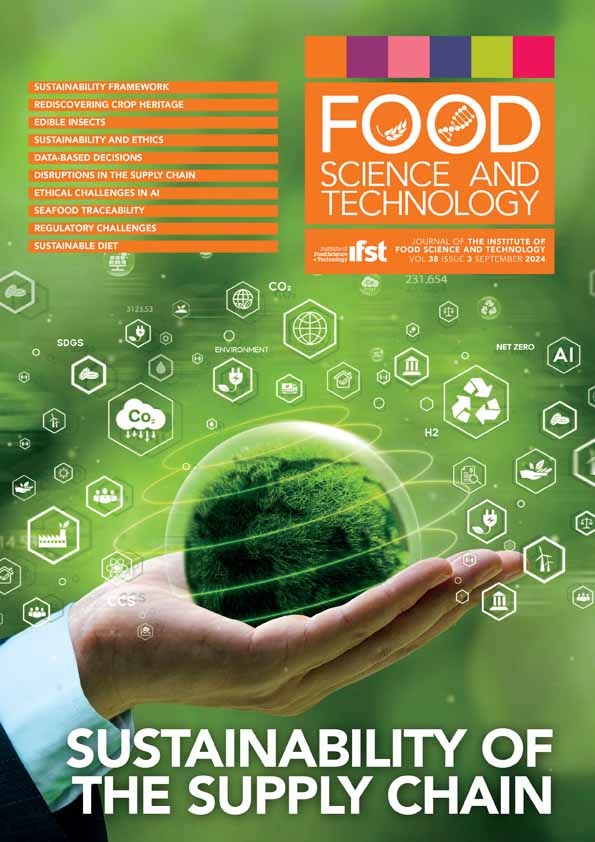Stabilization of natural antioxidants from Chillangua (Eryngium foetidum) by encapsulation
Q2 Agricultural and Biological Sciences
引用次数: 0
Abstract
The Chillangua (Eryngium foetidum) is 4a species of significant scientific interest due to its history and traditional uses throughout the world. Therefore, the focus of this research was on stabilizing the functional and antioxidant components of Chillangua through encapsulation with maltodextrin and Arabic gum. A central composite experimental design was used to evaluate the variables: type of encapsulant (maltodextrin and Arabic gum), encapsulant concentration (3% and 10%), and atomization temperature (130 and 160°C). The results showed that the fresh plant contained 1.34% fat, 17.47% protein, 22.90% fiber, 14.24% ash, and a pH of 6.88. Additionally, concentrations of 3,883.77 μg/g of chlorophyll a, 1,761.72 μg/g of chlorophyll b, 889.19 μg/g of carotenoids, 61.21 mg/g of total polyphenols, 0.02 mg/g of flavonoids, 1.29 mg/g of ascorbic acid, 40 µmol Trolox Eq/g, and 91.60 µmol Trolox/g of antioxidant activity by 2´2´-azinobis (3-ethylbenzothiazoline-6-sulfonic acid) (ABTS) and 2,2-difenil-1-picrilhidrazilo (DPPH), respectively, were identified. When encapsulating Chillangua, it is identified that a reduction occurs in its functional components, as well as its antioxidant activity. The maximum process optimization was achieved at 160°C with 3% maltodextrin and 3% Arabic gum. The irregular morphology of the particles contained C, O, K, Zn, Cl, Al, Ca, and Na.通过封装技术稳定寒天草(Eryngium foetidum)中的天然抗氧化剂
寒天草(Eryngium foetidum)因其历史和在世界各地的传统用途而备受科学界关注。因此,本研究的重点是通过麦芽糊精和阿拉伯胶的包囊作用来稳定 Chillangua 的功能和抗氧化成分。研究采用了中心复合实验设计来评估以下变量:封装剂类型(麦芽糊精和阿拉伯胶)、封装剂浓度(3% 和 10%)以及雾化温度(130 和 160°C)。结果显示,新鲜植物含脂肪 1.34%、蛋白质 17.47%、纤维 22.90%、灰分 14.24%,pH 值为 6.88。此外,叶绿素 a 浓度为 3883.77 微克/克,叶绿素 b 浓度为 1761.72 微克/克,类胡萝卜素浓度为 889.19 微克/克,总多酚浓度为 61.21 毫克/克,类黄酮浓度为 0.02 毫克/克,抗坏血酸浓度为 1.29 毫克/克。通过 2´2´-叠氮双(3-乙基苯并噻唑啉-6-磺酸)(ABTS)和 2,2-二苯基-1-双环戊二烯二缩水甘油醚(DPPH)分别鉴定出抗氧化活性为 40 µmol Trolox Eq/g 和 91.60 µmol Trolox/g。在封装 Chillangua 时,发现其功能成分和抗氧化活性都有所降低。在 3% 麦芽糊精和 3% 阿拉伯胶的条件下,160°C 的温度实现了工艺的最大优化。颗粒形态不规则,含有 C、O、K、Zn、Cl、Al、Ca 和 Na。
本文章由计算机程序翻译,如有差异,请以英文原文为准。
求助全文
约1分钟内获得全文
求助全文
来源期刊

Food Science and Technology
农林科学-食品科技
自引率
0.00%
发文量
0
审稿时长
12 weeks
期刊介绍:
Information not localized
 求助内容:
求助内容: 应助结果提醒方式:
应助结果提醒方式:


